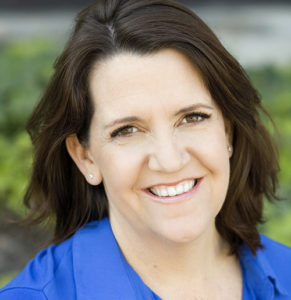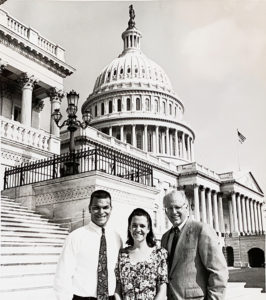
A lot has changed since the years I worked in Washington. While the member for whom I worked, Congressman Christopher Shays, is no longer in office, I believe there are still plenty of good people working in Washington who would agree with the “truths” I’m going to share. I urge you to set any cynicism aside for a moment and trust that yes, I learned these things in Washington, D.C., and in fact, was exposed to some of the most ethical people I have met in my career while working there.
I started my career on Capitol Hill. As a young college grad, I was drawn to the energy, excitement, and vibe of an engaged community of smart, interesting people from around the country working together. It was the early ’90s, and with Bill Clinton in the White House and the Republicans later gaining control of Congress, it was a great time to learn and grow.
People say working on the Hill is like dog years, and I agree. You work crazy long hours and are given immense responsibility and access at a very young age. When you leave (some only last a year or two; I was there for six, and a small few make a career out of it), you have the work experience and knowledge of someone much older.
Interestingly, much of what I learned during my time in Washington are things I draw upon to this day. At a fundamental level, it translates well to the research industry and to insights work in particular. A member of Congress is your brand, the legislation is your product, and your constituents are your customers. This model, which became obvious to me quickly upon my return to Silicon Valley, has served me well over the years. But what has perhaps influenced me more are seven fundamental truths that I learned working on Capitol Hill.

Truth 1: Share the Credit
In a world where so many people are focused on getting to the top, the member for whom I worked was obsessed with sharing credit. As a young staffer, I sometimes found this a bit annoying. Of course, we didn’t want to be arrogant, but sometimes I would see my boss work harder than anyone on a piece of legislation and land a coveted media interview, only to use the opportunity to praise someone else who had put in a fraction of the time and effort on the bill. I soon learned that it was more than altruism that drove this behavior.
When you share credit, you achieve your goals faster. I observed the member who got the perhaps undeserved praise for his work on the bill become much more inspired to work harder for its passage. That person you speak well of will perhaps also speak well of you. The colleague, who may have been inclined to fight you had you focused only on yourself, is now squarely on your side, as you pull each other—and your cause—forward.
This truth has broad applicability, including in the field of insights. When we partner with others, whether other researchers, our recruiters, or our technology partners, it behooves us to support and speak highly of one another. This will elevate our collective reputations, as well as the success of the project, and bind us together as we work toward a common goal.
Truth 2: Don’t Lie
It sounds obvious, but it’s actually not. People lie every day, many without seeing any harm in it, but if you can adopt a philosophy of not lying, so much falls into place.
It was a busy day, and the member was juggling multiple important and timely meetings in the office in between running to and from votes. An irate constituent called and asked to speak to the congressman. “He’s not here,” one of my fellow interns said, which seemed to me at the time like a perfectly reasonable response. The boss overheard him, put the call on hold, and asked the intern, “What did you just say?”
“He’s asking to talk to you, and you’re in a meeting and rushing out to a vote,” the intern explained.
“It’s true that I’m not available, but it’s a lie to say I’m not here. Never lie in my office.”
And with that, I learned fundamental truth number two.
It turns out, not lying takes a bit of effort, but lying takes even more. Abraham Lincoln once said, “No man has a good enough memory to be a successful liar,” and Ronald Reagan concurred, saying, “I’m not smart enough to lie.”
A practice of not lying is particularly good for insights. We are an ethical profession, of course, but I suspect that “little white lies” are pretty common in our field. This doesn’t mean we have to spill everything to our participants, and in fact, many times we can’t, but that’s different from simply not lying.
For example, if you’re bringing a client along to an in-home, you don’t have to introduce her as the vice president of product for XYZ Company, and of course for the integrity of the research, you don’t want to. But don’t lie, either. Instead of a seemingly innocent lie such as, “Sara is a researcher who works with me,” say “This is Sara who will be taking a few photos and may ask some questions as well.” It may sound unimportant and inconsequential, but it’s not. Just like us, participants can sniff out a lie and besides, once you become okay with lying, it can be difficult to know where and when to draw the line.
Truth 3: Don’t Say It Unless You’re Okay with It Being on the Front Page of the New York Times
When you work in Washington, you learn quickly that the person standing next to you in the elevator could be anyone, such as a staffer from another office or a reporter. As such, you learn to be very careful with your words. While it’s particularly important to do this while in elevators and other public places, the simplest solution is to adopt the practice in all conversations.
Interestingly, when you adopt this practice, you learn that being careful with your words does not necessarily mean only saying things that are nice and non-controversial. Let’s face it, that would be pretty boring and self-limiting. For me, it means speaking my truth and considering whether or not I’m truly comfortable with and proud of what I’m saying. It helps you avoid gossip and hold yourself accountable to your words.
Truth 4: Remove the Distractions
The member for whom I worked could easily and often get distracted by seemingly unimportant details. Whether it was misaligned papers, uneven spacing in a document, or mismatched fonts, an important meeting could easily get derailed if things were not buttoned up. Our chief of staff explained it to me like this, “His job is incredibly stressful, and he has a lot of content to manage. Sometimes he will inadvertently try to avoid making hard decisions by focusing on these seemingly unimportant details, so our job is to eliminate those distractions.”
We did this by attending to every detail. Every document used the same agreed-upon font, format, and style. We organized content into uniform briefing binders, all white and one inch wide with the topic typed out neatly in the same way. Staples were all oriented vertically. It might seem kind of ridiculous, but as a result, we could enter a meeting and dive straight into what was important.
As insights professionals, we can do the same thing. Our clients are busy and are managing a lot of topics and issues. Our participants are busy, too. These days, everyone is looking for a distraction, and we need to keep people focused. I cringe when I see some of the recruiting emails that are sent to participants, as well as some of the pre-programmed participant instructions in some of our online tools (think multiple font sizes, yellow highlighting, bold, italics, and everything in between). If that many instructions are needed, something is wrong. Similarly, you can do the best research in the world, but if your report’s formatting is busy and inconsistent, your message will get lost. Hire a designer to clean it up if you have to.
Truth 5: Get to the Bottom Line
Imagine you are the staffer responsible for advising a member of Congress on how to vote on a piece of legislation. The legislation is complex, and in your analysis and recommendation you have to factor in everything from your boss’s voting history on the issue, the latest news and public opinion, interest groups’ and constituents’ points of view, and myriad other factors. While the issue is not new, the bill has been under consideration for several hours and has been amended multiple times. Now it’s time for the vote on final passage, and you have to give a “yea” or “nay” recommendation.
It’s a fifteen-minute vote, which doesn’t seem like much time, but you think it should be enough. Unfortunately, he is caught up in an important phone call for the first nine minutes, and now there are six minutes left. It takes three to walk to the House floor, but just as your boss hangs up the phone, your colleague jumps ahead of you to ask him a question. Now there are three minutes left in the vote, and you are forced to explain the entire issue and your recommendation, and have time for questions, in this three-minute walk/run to the floor. As you can imagine, you have no choice but to “get to the bottom line.”
“Get to the bottom line” was a mantra in our Capitol Hill office. The pace is fast, and there are many issues to manage. To be clear, getting to the bottom line is not an innate skill for me. Like most in our profession, I like to process things, think about every angle, and dissect the information. The analytical process is just that—a process. But being forced to learn to get to the bottom line was incredibly valuable to me. This is not because the analysis is not important—of course it is—but once the analysis is done, we must take what we’ve learned and convey it in the most succinct way possible.
The member for whom I worked liked to know the bottom line first and then would ask questions—often very detailed ones—and we staffers were expected to know the answers immediately (because by now there’s only one minute left before that vote!). In the same way, we can present our research results with the bottom line first, and then have all of the details ready to back up our assertions and recommendations. I still find this challenging. I want to share all of the interesting things we learned. I want my clients to understand all of the “ahas” the way I do. I want to make sure not to “dumb down” a complex research question into what could be misconstrued as something simple or obvious. Nevertheless, I find that focusing on the bottom line is a best practice, and I strive to follow it.
Truth 6: The Power of a Pause
Each late afternoon and evening in a Capitol Hill office, time is set aside to return calls from the press. The press secretary (now called communications director) would lead this process, with the staffer responsible for the issue often sitting in. We would put talking points together and review them with the member before the call was made.
I remember sitting in on a press call with a reporter from the hometown paper. Every time she asked a question, my boss gave a great answer, right on point. I was so pleased that he was following the talking points as planned, and in my mind, his responses were perfect. But the reporter somehow did not understand and would often respond by saying “uh huh…?” It made no sense to me at first. I figured perhaps she was not too bright, as she clearly didn’t understand my boss’s perfectly scripted answers.
After a few of these calls, a lightbulb went off for me. (Apparently it had been me, not the reporter, who was dim.) She fully understood the answers she was getting, but she wanted more. Her “uh-huhs” were designed to create an uncomfortable silence that she hoped would be filled with whatever was not on the list of talking points. Of course, both she and my boss were seasoned (it’s likely that I was the only one who was truly uncomfortable), and I observed with fascination as they both waited out the silence, kind of like a game of chicken.
Of course, this technique translates beautifully into the field of qualitative research and fortunately for us, our participants tend not to be members of Congress with expertise in managing the press. The “uncomfortable pause” is a valuable tool in our tool belt, and I learned it, of all places, working on the Hill.
Truth 7: Look at the Micro to Achieve the Macro
One of the main pieces of legislation that I worked on was campaign finance reform. It’s a tough issue with a lot of complexity—everything from Constitutional issues to the very basic fact that the campaign finance system is essentially what got members and senators their coveted jobs, and they are the very people being asked to change it. Challenges were everywhere.
We had an amazing, smart, and diverse group of people working on campaign finance reform. It was a true bipartisan effort named for its Senate sponsors John McCain and Russ Feingold. We worked with a range of members, the press, and public interest groups with the goal of getting the bill passed.
I won’t go into the complicated processes and legislative maneuvers that we used to move the bill along, but want to share a particular moment that taught me one of my favorite “truths”—one that perhaps inspired my career in qualitative research, and most certainly has helped me with it.
We had done everything seemingly possible to get more supporters for the bill but had come up short of what was needed. We had held endless staff briefings and had launched an elaborate and targeted press tour. The bill’s sponsors had promoted the bill to their colleagues, and constituents from around the country were writing letters and making calls on the bill’s behalf. In short, we did everything that had ever been done before to get the most support, but it was not enough, and we were stuck.
I had to get more creative and decided to hold individual meetings with junior staffers of members who had refused support. These were members who were not particularly aligned with my boss and the other sponsors, and who had never expressed any interest in the legislation. It felt like an exercise in futility, but candidly, I was out of ideas.
These meetings turned out to be enlightening. We thought we understood the objections, as we had been working on the issue for years. But by listening deeply through one-on-one conversations with people who had probably never really been asked before, I learned new and unexpected things. As it turned out, some of their objections were small to us, but huge to these members, and were completely addressable. We were able to make some small adjustments to the legislation and bring members on board who had previously been written off as unsupportive.
This may sound obvious to a qualitative researcher, but I was not a qualitative researcher. I was a Capitol Hill staffer, and the experience reminds me to this day that it’s not necessarily intuitive or obvious to know that deep, personalized conversations can lead to understanding if not enlightenment.
I am eternally grateful for my years on Capitol Hill and all that I learned there. I love that I can continue to apply those learnings and how directly applicable they are to the field of insights.


Be the first to comment